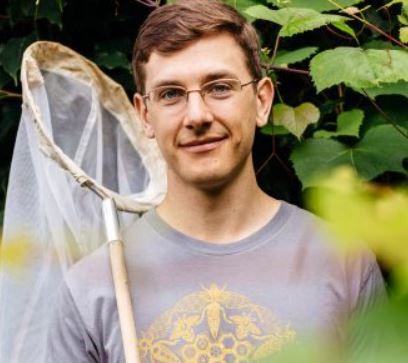Gonzaga Graduate Callin Switzer Researches Bumblebee Vibrations at Harvard
Thursday, May 25, 2017

SPOKANE, Wash. – Callin Switzer, a 2010 Gonzaga University graduate in biology, is abuzz about bumblebees through his doctoral work in organismic and evolutionary biology at Harvard University.
Switzer, who follows bees around Harvard’s Arnold Arboretum and records their vibrations through a microphone, has determined that bumblebees flap their wings and shake their bodies at a frequency of approximately 270 hertz (cycles per second) – far too fast to see.
Bumblebee photo taken by Callin Switzer.
“I’m investigating bumblebee behavior and interactions with plants that are too fast for the naked eye to see,” he said. “I am studying bees partly because their pollination is so important for humans’ food supply.”
Switzer’s research is focused on “buzz pollination,” an unusual method wherein bumblebees and other species liberate pollen from a flower to gather food for their colonies.
His research may influence how pesticides are used. Bumblebees contract their strong flight muscles and create vibrations that may be the most efficient way to pollinate some plants such as tomatoes and blueberries – something many other bee species simply cannot do.
He is also working on a project to study bees’ ability to learn to vibrate at the optimal frequency to pollinate certain types of plants. Previous research has shown that bees can learn from one another. Switzer’s research involves placing bumblebees in laboratory “flight cages” to measure how well they learn certain behaviors.
Switzer said his time at Gonzaga “made me want to be a scientist,” especially his studies with Professor Brook Swanson. Swanson taught a biomechanics class focused on plant and animal structures, movement and materials that influence them. The class prompted Switzer to wonder how he could improve humans’ lives through biological research. Another formative research experience was Switzer’s junior semester abroad at the School for Field Studies in Queensland, Australia.
During his undergraduate career, Switzer – who hails from Belgrade, Montana – researched crustaceans’ structure with Swanson for a semester. He studied echinacea, a coneflower largely used in herbal medicine, in Minnesota for a summer.
Switzer also earned a minor in music performance from Gonzaga and played the violin all four years. He still enjoys music and practices the mandolin, guitar and banjo in his spare time. His appreciation for nature also led him to join Gonzaga Outdoors.
After graduation, Switzer taught science at John F. Kennedy Middle School in Gallup, New Mexico, through the Teach for America program – a nonprofit national teacher corps of college graduates who commit to teach for two years at under-resourced urban and rural public schools.
“It seemed like a good thing to do,” he said. “Gonzaga emphasized being a good, well-rounded person and people around campus often talked about Teach for America.”
After completing his doctorate from Harvard this summer, Switzer will continue his work with pollinators as a research associate at the University of Washington’s eScience Institute.
